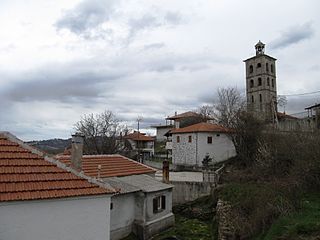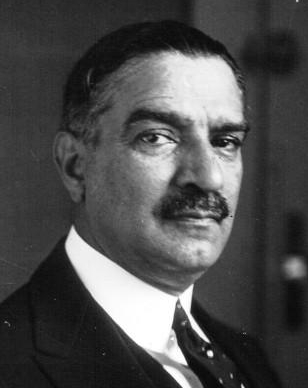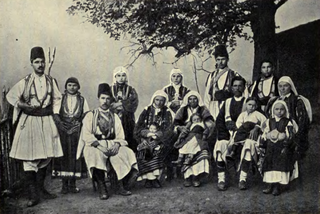Related Research Articles

The Balkan Wars were a series of two conflicts that took place in the Balkan states in 1912 and 1913. In the First Balkan War, the four Balkan states of Greece, Serbia, Montenegro and Bulgaria declared war upon the Ottoman Empire and defeated it, in the process stripping the Ottomans of their European provinces, leaving only Eastern Thrace under the Ottoman Empire's control. In the Second Balkan War, Bulgaria fought against the other four original combatants of the first war. It also faced an attack from Romania from the north. The Ottoman Empire lost the bulk of its territory in Europe. Although not involved as a combatant, Austria-Hungary became relatively weaker as a much enlarged Serbia pushed for union of the South Slavic peoples. The war set the stage for the July crisis of 1914 and thus served as a prelude to the First World War.

The region of Macedonia is known to have been inhabited since Paleolithic times.

The Internal Macedonian Revolutionary Organization, was a secret revolutionary society founded in the Ottoman territories in Europe, that operated in the late 19th and early 20th centuries.

The Ilinden–Preobrazhenie Uprising, or simply the Ilinden Uprising, of August–October 1903, was organized revolt against the Ottoman Empire, which was prepared and carried out by the Internal Macedonian-Adrianople Revolutionary Organization, with the support of the Supreme Macedonian-Adrianople Committee, which included mostly Bulgarian military personnel. The name of the uprising refers to Ilinden, a name for Elijah's day, and to Preobrazhenie which means Feast of the Transfiguration. Some historians describe the rebellion in the Serres revolutionary district as a separate uprising, calling it the Krastovden Uprising, because on September 14 the revolutionaries there also rebelled. The revolt lasted from the beginning of August to the end of October and covered a vast territory from the western Black Sea coast in the east to the shores of Lake Ohrid in the west.

Bulgarians in Serbia are a recognized national minority in Serbia. According to the 2022 census, the population of ethnic Bulgarians in Serbia is 12,918, constituting 0.2% of the total population. The vast majority of them live in the southeastern part of the country that borders Bulgaria and North Macedonia.

The Tsardom of Bulgaria, also referred to as the Third Bulgarian Tsardom, sometimes translated in English as the "Kingdom of Bulgaria", or simply Bulgaria, was a constitutional monarchy in Southeastern Europe, which was established on 5 October 1908, when the Bulgarian state was raised from a principality to a tsardom.

Ano Vrontou is a remote mountain village and a former community in the northern Serres regional unit, Greece. Since the 2011 local government reform it is part of the municipality Serres, of which it is a municipal unit. Each year on August astrophotography hobbyists gather there due to the clear view of the night sky, a result of the villages high elevation. The municipal unit has an area of 47.306 km2. Ano Vrontou is situated in the northeastern part of the Vrontous mountains, at about 1060 m elevation. It borders on the Drama regional unit to the north and east. Ano Vrontou is 6 km northwest of Kato Vrontou, 12 km east of Achladochori, 13 km northeast of Oreini, 16 km southwest of Kato Nevrokopi and 26 km northeast of Serres.

Macedonian nationalism is a general grouping of nationalist ideas and concepts among ethnic Macedonians that were first formed in the late 19th century among separatists seeking the autonomy of the region of Macedonia from the Ottoman Empire. The idea evolved during the early 20th century alongside the first expressions of ethnic nationalism among the Slavs of Macedonia. The separate Macedonian nation gained recognition during World War II when the Socialist Republic of Macedonia was created as part of Yugoslavia. Macedonian historiography has since established links between the ethnic Macedonians and various historical events and individual figures that occurred in and originated from Macedonia, which range from the Middle Ages up to the 20th century. Following the independence of the Republic of Macedonia in the late 20th century, issues of Macedonian national identity have become contested by the country's neighbours, as some adherents to aggressive Macedonian nationalism, called Macedonism, hold more extreme beliefs such as an unbroken continuity between ancient Macedonians, and modern ethnic Macedonians, and views connected to the irredentist concept of a United Macedonia, which involves territorial claims on a large portion of Greece and Bulgaria, along with smaller regions of Albania, Kosovo and Serbia.
The National Liberation Front, also known as the People's Liberation Front, was a communist political and military organization created by the Slavic Macedonian minority in Greece. The organization operated from 1945–1949, most prominently in the Greek Civil War. As far as its ruling cadres were concerned its participation in the Greek Civil War was nationalist rather than communist, with the goal of secession from Greece.

Ohrana were armed collaborationist detachments organized by the former Internal Macedonian Revolutionary Organization (IMRO) structures, composed of Bulgarians in Nazi-occupied Greek Macedonia during World War II and led by officers of the Bulgarian Army. Bulgaria was interested in acquiring Thessalonica and Western Macedonia, under Italian and German occupation and hoped to sway the allegiance of the 80,000 Slavs who lived there at the time. The appearance of Greek partisans in those areas persuaded the Axis to allow the formation of these collaborationst detachments. However, during late 1944, when the Axis appeared to be losing the war, many Bulgarian Nazi collaborators, Ohrana members and VMRO regiment volunteers fled to the opposite camp by joining the newly founded communist SNOF. The organization managed to recruit initially 1,000 up to 3,000 armed men from the Slavophone community that lived in the western part of Greek Macedonia.

The Abecedar was a school book first published in Athens, Greece, in 1925. The book became the subject of controversy with Bulgaria and Serbia when cited by Greece as proof it had fulfilled its international obligations towards its Slavic-speaking minority, because it had been printed in the Latin alphabet rather than the Cyrillic used by the Slavic languages of the southern Balkans. The book was initially published for the Slavic speakers of Greek Macedonia in the Lerin dialect, and today it is published in Standard Macedonian, Standard Greek and Standard English.

Greco–Romanian relations are foreign relations between Greece and Romania. Both countries are full members of the Council of Europe, the European Union, NATO and United Nations.
Slavic speakers are a minority population in the northern Greek region of Macedonia, who are mostly concentrated in certain parts of the peripheries of West and Central Macedonia, adjacent to the territory of the state of North Macedonia. Their dialects are called today "Slavic" in Greece, while generally they are considered Macedonian. Some members have formed their own emigrant communities in neighbouring countries, as well as further abroad.

Little Sofia is a designation applied to localities outside the modern borders of Bulgaria; it is used in the late Ottoman era to emphasize the population's strong Bulgarian national identity. The term most often refers to villages in the region of Macedonia during the late Ottoman era and for a brief period after.

Macedonians or Macedonian Bulgarians, sometimes also referred to as Macedono-Bulgarians, Macedo-Bulgarians, or Bulgaro-Macedonians are a regional, ethnographic group of ethnic Bulgarians, inhabiting or originating from the region of Macedonia. Today, the larger part of this population is concentrated in Blagoevgrad Province but much is spread across the whole of Bulgaria and the diaspora.

The Incident at Petrich, or the War of the Stray Dog, was a Greek–Bulgarian crisis in 1925 that resulted in a brief invasion of Bulgaria by Greece near the border town of Petrich after the killing of a Greek captain and a sentry by Bulgarian soldiers. The incident ended after a decision by the League of Nations.

The Greek–Serbian Alliance of 1913 was signed at Thessaloniki on 1 June 1913, in the aftermath of the First Balkan War, when both countries wanted to preserve their gains in Macedonia from Bulgarian expansionism. The treaty formed the cornerstone of Greek–Serbian relations for a decade, remaining in force through World War I until 1924.

The Greek–Romanian Non-Aggression and Arbitration Pact was a non-aggression pact signed between Greece and Romania on 21 March 1928. The pact effectively ended Greece's diplomatic isolation within the Balkan peninsula, strengthening its position on the negotiating table with Bulgaria, Yugoslavia and Turkey. Romania on the other hand gained a regional ally against its Slavic neighbors.

Slavic-speakers inhabiting the Ottoman-ruled region of Macedonia had settled in the area since the Slavic migrations during the Middle Ages and formed a distinct ethnolinguistic group. While Greek was spoken in the urban centers and in a coastal zone in the south of the region, Slav-speakers were abundant in its rural hinterland and were predominantly occupied in agriculture. Habitually known and identifying as "Bulgarian" on account of their language, they also considered themselves as "Rum", members of the community of Orthodox Christians.

The Politis–Kalfov Protocol was bilateral document signed at the League of Nations in Geneva in 1924 between Greece and Bulgaria and was concerning the “protection of the Bulgarian minority in Greece.” However it was not ratified by the Greek side.
References
- ↑ Костадин Тодоров Хаджиянакиев. Гръцкото злодеяние в с. Търлис, Драмско през 1924 г., Македония, брой 36, 7 октомври 1998 г., с. 6.
- ↑ "Review of Chairs of History at Law and History Faculty of South-West University - Blagoevgrad, vol. 1/2003, p. 8" (PDF). Archived from the original (PDF) on 2011-10-07. Retrieved 2008-12-06.
- ↑ Greco-Bulgarian Communities, Advisory Opinion, 1930 P.C.I.J. (ser. B) No. 17 (July 31) p. 37 Archived 2012-09-19 at archive.today